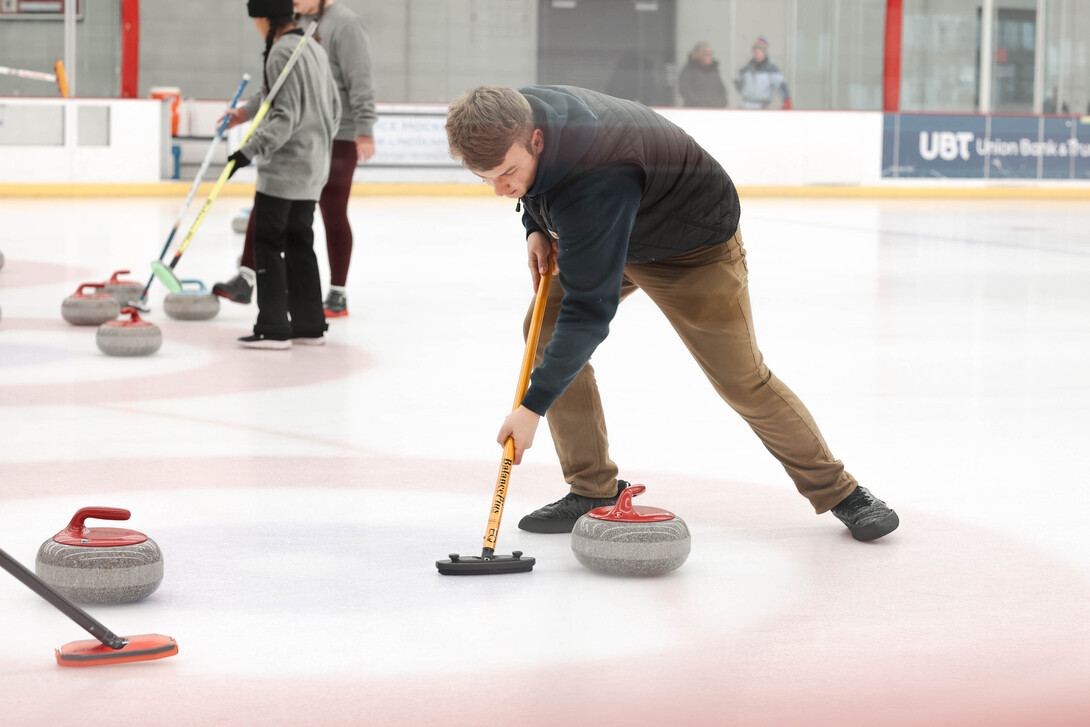
Curlers from universities around the nation swept into the Breslow Ice Hockey Center Jan. 19-21 for the University of Nebraska–Lincoln Curling Club’s annual Cornhusker Bonspiel curling tournament.
Nancy Myers, adviser and coach for the Husker club, said the respectful sport requires an understanding of physics and precision to hit the mark.
“People generally underestimate curling and the skill it takes,” she said. “You have to have good balance, aim, and you have to figure out how much strength you need to get the stone where it needs to be on the other end of the ice.”
The tournament featured 14 teams from nine universities competing for an automatic entry into the National College Curling Championship. Two Husker teams competed, with each winning their match in the final round on Jan. 21. A team from Arizona State University earned the Emerging Region’s automatic entry into the national tourney.
Nebraska’s club started in 2008 and earned silver medals at the National College Curling Championship in 2016 and 2017. The team typically competes in four or five tournaments every year, traveling to places like Minnesota and Wisconsin. This year’s squad has around a dozen members and practices weekly at Breslow. In addition to competing, they also hold “learn to curl” events for the public throughout the year.
In order to prepare for the influx of curlers to Breslow, staff had to flood the ice and smooth it. Myers, who is also chair of the USA College Curling Committee, said the ice must be smooth and level for curling, or the surface can affect the direction of the stone.
“We don’t like skating divots,” Myers said. “You hit a curling stone on a skating divot, it can ricochet out to Kansas.”
In curling, two teams of four take turns moving the curling stone in what is called a “delivery” or “throw.” Players use a curling broom or brush to sweep the stone toward a target and earn points for how close stones land to the target.
“People think that’s a little strange, to take a broom and sweep ice, but if the stone is going too slow, it will put 10 to 15 feet on that stone. The sweeping helps it to get to its target and it keeps it on its trajectory.”

Between games, members of opposing teams often get together to have lunch, play board games or talk curling strategy. It’s part of a concept curlers call “broom stacking,” when competitors are encouraged to socialize between matches to build relationships. Myers said the respectfulness of curling is inherent to the sport and is part of the appeal for some participants.
“If you go to a curling match in Great Britain or Scotland or Finland, you’ll see that same level of respect,” Myers said. “It’s part of the culture of the sport.”
This dynamic was something Emma Whaley, a senior English major from Omaha and vice president of the University of Nebraska–Lincoln club, said she noticed about curling right away after joining as a freshman. As a sophomore she attended the national tournament, where members of Penn State’s curling team gifted the team dinosaur stuffed animals.
“You get there and everyone immediately greets you, ‘It’s been so long, I haven’t seen you since November,’ ‘How was finals?’” she said. “It’s a really friendly environment, and that definitely does continue onto the ice.”
While on the ice during a game, Whaley said the atmosphere is intense and focused, but that members of opposing teams maintain the level of respect.
“There’s a lot of respect for other people on the ice,” she said. “Whether it’s your team or other teams, we’re going to be quiet for their delivery, we’re going to step out of the way when their sweepers come by.”

She said her favorite aspect of any tournament is the excitement and tension when a game comes down to the wire.
“I really like a nail-biter final stone,” Whaley said. “I really like when that last stone is going to win it all and it’s a really tight shot. When they make it and the other team is congratulating you, that always feels good.”
She said competing against a lot of other teams is also a chance to take lessons from players of various levels of experience and get ideas for how she can improve her own game. Some college curlers are youth champions with USA Curling with years of training.
“Some of these players I look at and they’re like role models,” Whaley said. “I’m always learning something new, like a new way of sweeping or way to improve my form.”







